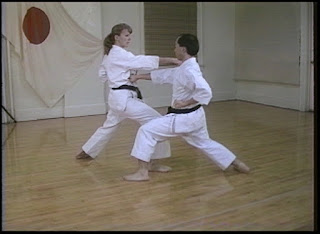by Phillip
Starr
There
is a Japanese proverb that tell us,
“A man
is judged by how he opens the door.
A woman is
judged by how she shuts it.”
To
grasp the meaning of this statement, it's first necessary to
understand something of the architecture (and doors), as well as some
of the customs of ancient Japan. Unlike the hinged doors of the
West, Japanese doors slid back and forth along grooved wooden tracks
on the floor. They were generally opened in the same way; you knelt
at the crack of the door and gently pushed it open before entering
the room (often done by sliding on the knees). Well-bred people knew
the you use the hand nearest to door to open it a bit (“the length
of a forefinger”, according to one old school of proper etiquette),
then switch hands and open it the rest of the way. This is an
extremely simplified explanation of how this is to be done. There
are all kinds of manners to be observed in the simple action of
entering a room in so far as the protocols of old Japan are
concerned. During the feudal times, even an ordinary thing such as
entering a room had significance and a certain order that evolved
around it. Such a
simple act, when performed with the proper spirit and mental attitude
could be seen as a type of kata and the meaning of the expression
shown at the beginning of this article is to be found in that spirit
and attitude. Look...it'd be pretty easy to make a flashy, macho
entrance through a Japanese style door. You could sling it open so
it whacks the frame, swagger in, and stand tall. But in an old
Japanese home, people sat on the floor and as you swagger into the
room, you'll tower over all of them. Yes, you'll be an imposing
figure and have everone's attention. To many people, this would seem
like a fine way to enter a room...so why does Japanese etiquette
require the exact opposite?
.jpg)
The
answer would be that many of the manners found in Japan are aimed at
preserving social harmony. Getting along with the other fellow was
important, as was the idea that the individual's welfare was not so
significant as the welfare of the group. This way of thinking can be
found in other cultures but in Japan, it was of paramount importance.
The higher one sat in the social order, the more humble and
self-effacing was his conduct. That is, the “classier” the
individual, the less he felt that he needed to display himself.
Secure in his social position, he didn't need to remind himself or
others of his status. He entered the room quietly and shuffled in on
his knees so that he maintained a level equal to that of others in
the room. So, a man can be judged by how he enters a room...but why
the distinction between men and women? Is it indicative of a
different standard of manners between the sexes?

Well,
yes. In old Japan, women were often in subordinate positions; if a
group of men were in the room, it would likely be a woman who served
tea and various foods. She would then leave, closing the door
behind her. But the distinction made in the saying about gender is
superfluous; what matters is the spirit and attitude with which an
individual conducts him or her self.
This
spirit and attitude has pervaded Japanese culture and as the martial
arts (of Japan) are a product of that culture, it should come as no
surprise that such concepts are an integral part of the martial ways.
And that's also why it's so disappointing to see many people who
claim to be serious about making the martial ways a part of their
lives remain determinedly ignorant of this spirit and who (worse
still) choose to disregard it. Such forms of etiquette also exist
within the culture of China, although they're not so easy to see.
But if you know what to look for, you'll see them there as well.
.jpg)
How
many times have I seen some martial arts “master” come strutting
onto the floor of a tournament usually with the title emblazoned on
the back of his uniform) or the winning competitor prancing around
the ring with his hands held high! If you've seen similar things,
then you've been an unfortunate witness to the arrogant and ignorant
disregard for the traditions in which the arts were developed. The
skills of opening and closing a sliding door are a part of “reishiki”
(etiquette) as is moving in a balanced, graceful way when sliding on
one's knees along the floor and it's this mastery of the self that
allows us to get along with others and present ourselves to the world
in a respectful way.

Sadly,
such things are disappearing in our modern world. People who are
conversant with these traditions tend to be exponents of the
classical arts, such as martial arts and the tea ceremony; people who
are willing to spend time to learn things that seem to be of little
practical, modern value. Although in present day Japan, you'd get
along just fine without knowing much about these things but still,
some manners (which have been called those “unwritten laws by which
the people keep even the kings in awe”) have a way of transcending
time and immediate circumstance. We are all judged by the little
things we do...like entering or leaving a building. Those who follow
the traditional martial ways are aware that outer form is often an
expression of an inner state. This should give you something to
consider the next time you open or close a door, whether you turn the
knob, push it, or slide it along a track...









.jpg)


.jpg)



.jpg)
.jpg)
.jpg)








.jpg)

.jpg)

.jpg)

.jpg)
.jpg)
.jpg)
.jpg)
.jpg)










.jpg)
.jpg)















